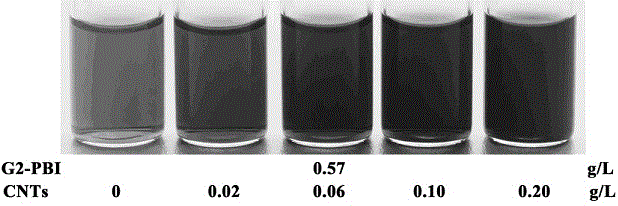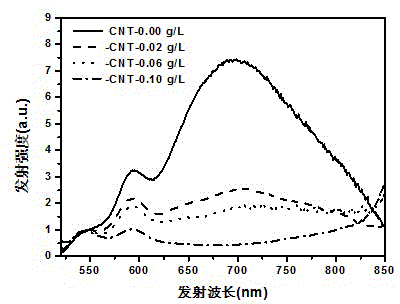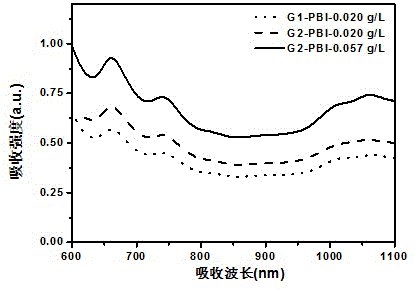Temperature-responsive supramolecular branched carbon nanotubes and preparation method thereof
A carbon nanotube, temperature-responsive technology, applied in nanotechnology, nanotechnology, nanotechnology for materials and surface science, etc., to achieve improved dispersibility, excellent dispersibility and stability, good dispersibility and stability. Effect
- Summary
- Abstract
- Description
- Claims
- Application Information
AI Technical Summary
Problems solved by technology
Method used
Image
Examples
Embodiment 1
[0023] Example 1: Four amounts of carbon nanotubes, respectively 0.1, 0.3, 0.5, and 1.0 mg, were added to 5 mL of the same substance with a concentration of 1.05×10 -4 M / L (converted to mass concentrations of first-generation and second-generation peryleneimide concentrations of 0.2 g / L and 0.57 g / L) and G1-PBI and G2-PBI aqueous solutions with the same mass concentration of 0.2 g / L. Sonicate in ice water for 45 minutes at 99W power. The resulting mixture was then centrifuged at 10,000 rpm for 30 minutes, and the supernatant was removed. The prepared product has excellent dispersibility and stability in water, and no precipitation occurs after being placed for half a year. The dispersion effect of carbon nanotubes with a mass concentration of 0.57 g / L second-generation peryleneimide is shown in figure 1 .
Embodiment 2
[0024] Example 2: The supramolecular interaction between the first-generation peryleneimide and carbon nanotubes was studied by fluorescence emission spectroscopy. Such as figure 2 It is shown that the first-generation peryleneimide has a strong emission peak at 700 nm when no carbon nanotubes are added. But with the increasing amount of carbon nanotubes added, the emission peak intensity gradually decreased. The reason is that with the gradual increase in the amount of carbon nanotubes added, more first-generation peryleneimides are adsorbed on the surface of carbon nanotubes, resulting in the quenching of fluorescence and a gradual decrease in the intensity of the emission peak. There is a similar effect between imines and carbon nanotubes. This characterization means shows that the present invention has prepared dendritic carbon nanotubes by supramolecular means.
Embodiment 3
[0025] Example 3: The dispersibility of peryleneimides of different generations on carbon nanotubes was studied by near-infrared absorption spectroscopy. Such as image 3 As shown, there are characteristic absorption peaks of uniformly dispersed carbon nanotubes at 600-800nm and 800-1100nm. And the peak intensity has a linear relationship with the dispersed concentration of carbon nanotubes. It can be seen from the figure that under the same amount of carbon nanotubes added, when the mass concentration of the first-generation peryleneimide and the second-generation peryleneimide are both 0.2 g / L, the dispersion concentration of the second-generation peryleneimide on the carbon nanotubes is slightly Higher than the first-generation peryleneimide; when the first-generation and second-generation peryleneimides have the same concentration, that is, when the mass concentration is 0.2 g / L and 0.57 g / L, the second-generation peryleneimide has a greater effect on carbon nanotubes. ...
PUM
 Login to View More
Login to View More Abstract
Description
Claims
Application Information
 Login to View More
Login to View More - R&D
- Intellectual Property
- Life Sciences
- Materials
- Tech Scout
- Unparalleled Data Quality
- Higher Quality Content
- 60% Fewer Hallucinations
Browse by: Latest US Patents, China's latest patents, Technical Efficacy Thesaurus, Application Domain, Technology Topic, Popular Technical Reports.
© 2025 PatSnap. All rights reserved.Legal|Privacy policy|Modern Slavery Act Transparency Statement|Sitemap|About US| Contact US: help@patsnap.com



